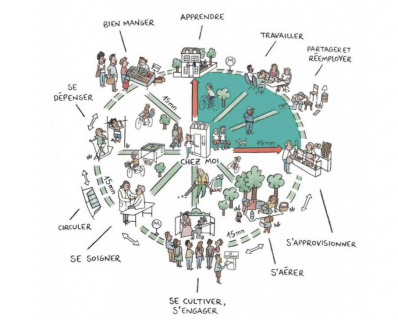Without changing the transport system in which they operate, the advent of autonomous cars will not significantly improve the quality of life in our cities. This has been discussed in previous contributions. This change includes prioritizing investment in developing high-quality public transport and autonomous minibuses to cover the first and last mile.
However, this is not enough by itself. The need to reduce the distances we travel daily also applies to transporting raw materials and food around the world. This is the subject of a new series of blog posts, and probably the last.
Over the next few weeks I will be discussing the sustainability of the need for people and goods to travel long distances. In many cities, the corona pandemic has been a boost to this idea. Paris is used as an example. But what applies to Paris applies to every city.
When Anne Hidalgo took office as the newly elected mayor in 2016, her first actions were to close the motorway over the Seine quay and build kilometres of cycle paths. Initially, these actions were motivated by environmental concerns. Apparently, there was enough support for these plans to ensure her re-election in 2020. She had understood that measures to limit car traffic would not be enough. That is why she campaigned on the idea of "La Ville du Quart d'Heure", the 15-minute city, also known as the "complete neighbourhood". In essence, the idea is to provide citizens with almost all of their daily needs - employment, housing, amenities, schools, care and recreation - within a 15-minute walk or bike ride of their homes. The idea appealed. The idea of keeping people in their cars was replaced by the more sympathetic, empirical idea of making them redundant.
During pandemics, lockdowns prevent people from leaving their homes or travelling more than one kilometer. For the daily journey to work or school, the tele-works took their place, and the number of (temporary) "pistes á cycler" quickly increased. For many Parisians, the rediscovery of their own neighbourhood was a revelation. They looked up to the parks every day, the neighbourhood shops had more customers, commuters suddenly had much more time and, despite all the worries, the pandemic was in a revival of "village" coziness.
A revival, indeed, because until the 1960s, most of the inhabitants of the countries of Europe, the United States, Canada and Australia did not know that everything they needed on a daily basis was available within walking or cycling distance. It was against this backdrop that the idea of the 15-minute city gained ground in Paris.
We talk about a 15-minute city when neighbourhoods have the following characteristics
- a mix of housing for people of different ages and backgrounds - pedestrians and cyclists
- Pedestrians and cyclists, especially children, can safely use car-free streets.
- Shops within walking distance (up to 400 meters) for all daily needs
- The same goes for a medical center and a primary school.
- There are excellent public transport links;
- Parking is available on the outskirts of the neighbourhood.
- Several businesses and workshops are located in each neighbourhood.
- Neighbourhoods offer different types of meeting places, from parks to cafes and restaurants.
- There are many green and leafy streets in a neighbourhood.
- The population is large enough to support these facilities.
- Citizens have a degree of self-management.
Urban planners have rarely lost sight of these ideas. In many cities, the pandemic has made these vague memories accessible goals, even if they are far from reality.
In the next post, I will reflect on how the idea of the 15-minute city is moving from dream to reality.
Below you can link to my free downloadable e-book: 25 Building blocks to create better streets, neighborhoods and cities






Does 15 mintes city fit each uirban settlement on the globe? What are the costs? what are the challenges to become a 15 minutes city? What are the negative considerations to become 15 minutes city? How many cities around the globe achieved "a recognition" for being 15 minutes city?